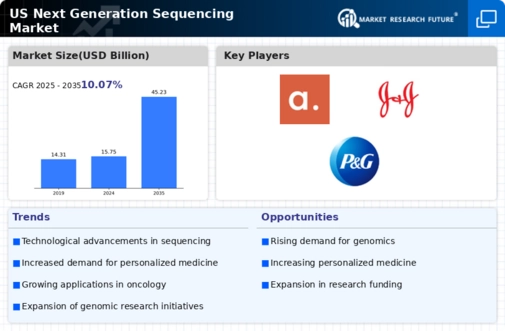Expansion of Research Funding
The allocation of increased funding for genomic research significantly influences the next generation-sequencing market. In recent years, federal and private institutions have recognized the importance of genomics in advancing medical science. For instance, the National Institutes of Health (NIH) has committed substantial resources to genomics research, with funding exceeding $1 billion annually. This financial support fosters innovation and drives the development of next generation-sequencing technologies. As researchers gain access to advanced sequencing tools, the potential for groundbreaking discoveries in areas such as cancer genomics and rare diseases expands. The influx of funding not only accelerates research but also stimulates demand for sequencing services, thereby propelling the growth of the next generation-sequencing market.
Growing Applications in Oncology
The expanding applications of next generation-sequencing in oncology represent a crucial driver for the market. As cancer research progresses, the need for comprehensive genomic profiling becomes increasingly evident. Next generation-sequencing enables the identification of genetic mutations and alterations that drive tumorigenesis, facilitating the development of targeted therapies. The oncology segment of the next generation-sequencing market is expected to account for over 40% of the total market share by 2026. This growth is attributed to the rising incidence of cancer and the demand for personalized treatment strategies. Furthermore, collaborations between pharmaceutical companies and sequencing providers are likely to enhance the integration of genomic data into clinical trials, thereby accelerating the development of innovative cancer therapies.
Increased Focus on Genetic Testing
The growing awareness and acceptance of genetic testing among the population serve as a significant driver for the next generation-sequencing market. As individuals become more informed about the benefits of genetic testing, the demand for comprehensive genomic analysis rises. This trend is reflected in the increasing number of genetic tests available, which has surged by over 30% in the past five years. Healthcare providers are increasingly incorporating genetic testing into routine care, particularly for hereditary conditions and predispositions to diseases. The next generation-sequencing market is poised to benefit from this shift, as it offers the high-throughput capabilities necessary for large-scale genetic testing. Consequently, the integration of genetic testing into healthcare practices is likely to continue, further enhancing the market's growth prospects.
Rising Demand for Personalized Medicine
The increasing emphasis on personalized medicine is a pivotal driver for the next generation-sequencing market. As healthcare shifts towards tailored treatments, the need for precise genetic information becomes paramount. This trend is evidenced by the projected growth of the personalized medicine sector, which is expected to reach $2.4 trillion by 2024. The next generation-sequencing market plays a crucial role in this transformation, providing the necessary genomic data to inform treatment decisions. Furthermore, advancements in sequencing technologies enhance the ability to identify genetic variations, thereby facilitating the development of targeted therapies. Consequently, the integration of next generation-sequencing into clinical practice is likely to expand, as healthcare providers seek to improve patient outcomes through individualized treatment plans.
Technological Innovations in Sequencing Platforms
Technological innovations in sequencing platforms are a driving force behind the evolution of the next generation-sequencing market. Recent advancements have led to the development of faster, more accurate, and cost-effective sequencing technologies. For instance, the introduction of portable sequencing devices has made genomic analysis more accessible, enabling researchers and clinicians to conduct tests in real-time. The market for next generation-sequencing platforms is projected to grow at a CAGR of 20% through 2027, reflecting the increasing adoption of these technologies. As new platforms emerge, they are likely to enhance the capabilities of genomic research and clinical diagnostics, thereby expanding the applications of next generation-sequencing in various fields, including oncology and infectious diseases.














Leave a Comment